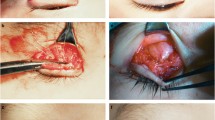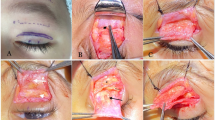Abstract
Purpose
Severe congenital ptosis is commonly associated with poor levator function. This study compares the functional and cosmetic outcomes of open versus closed frontalis sling using Gore-Tex in the treatment of such conditions.
Methods
Randomized interventional comparative case series of 20 eyes of 13 patients with severe congenital ptosis with levator excursion < 4 mm. Patients were treated by frontalis suspension using Gore-Tex string sutures either through a skin crease incision (group 1) or supraciliary incisions (group II).
Results
Mean age was 5.10 ± 3.10 years in group I and 7.30 ± 4.47 years in group II. Ptosis was unilateral in six patients and bilateral in seven patients. Following surgery, there was a statistically significant improvement in the palpebral fissure width (PFW) and marginal reflex distance (MRD) in both groups (p value 0.001) with better functional outcome in group II (closed approach). The cosmetic results were better in group I (open approach). The mean operative time in group II was 18.1 ± 2.4 min, which was significantly shorter than group I (30.2 ± 3.1 min). No recurrence or grave complications were encountered during follow-up.
Conclusion
Gore-Tex is a useful sling material for correction of severe congenital ptosis due to poor frontalis action. Open transcrease approach is recommended in absence of lid crease whereas closed approach is better used in cases with preserved crease due to its superior functional outcome

Similar content being viewed by others
References
Langford JD, Linberg JV, Blaylock WK et al (1998) Axial myopia in congenital ptosis: an animal model. Ophthal Plast Reconstr Surg 14:261–5
Kao SC, Tsai CC, Lee SM et al (1998) Astigmatic change following congenital ptosis surgery. Zhonghua Yi Xue Za Zhi (Taipei) 61(12):689–93
Felicia DA, Vikram DD (2010) Current techniques in surgical correction of congenital ptosis. Middle East Afr J Ophthalmol 17(2):129–33
Ben Simon GJ, Macedo AA, Schwarcz RM et al (2005) Frontalis suspension for upper eyelid ptosis:evaluation of different surgical designs and suture material. Am J Ophthalmol 140(5):877–85
Ramirez OM, Pena G (2004) Frontalis Muscle Advancement: A Dynamic Structure for the treatment of Severe Congenital Eyelid Ptosis. Plast Reconstr Surg 113:1841–51
Takahashi Y, Leibovitch I, Kakizaki H (2010) Frontalis suspension surgery in upper eyelid blepharoptosis. Open Ophthalmol J 14(4):91–7
Yagci A, Egrilmez S (2003) Comparison of cosmetic results in frontalis sling operations: the eyelid crease incision versus the supralash stab incision. J Pediatr Ophthalmol Strabismus 40(4):213–6
Moin M (2006) Tarsal fixation of fascia lata in frontalis sling ptosis surgery. Pak J Ophthalmol 22(3):124–9
Kersten RC, Bemardini FP, Khouri L et al (2005) Unilateral frontalis sling for the surgical correction of unilateral poor-function ptosis. Ophthalmic Plastic Reconst Surg 21(6):412–7
Deenstra W, Melis P, Kon M et al (1996) Correction of severe blepharoptosis. Ann Plast Surg 36(4):348–53
Hayashi K, Katori N, Kasai K et al (2013) Comparison of nylon monofilament suture and polytetrafluoroethylene sheet for frontalis suspension surgery in eyes with congenital ptosis. Am J Ophthalmol 155(4):654–64
Mencia-Gutierrez E, Clariana-Martin A, Gutierrez-Diaz E (2005) Results and complications of expanded polytetrafluoroethylene in frontalis suspension ptosis surgery. Arch Soc Esp Oftalmol 80(8):443–8
Author information
Authors and Affiliations
Corresponding author
Ethics declarations
Funding
No funding was received for this research.
Conflict of interest
All authors certify that they have no affiliations with or involvement in any organization or entity with any financial interest (such as honoraria; educational grants; participation in speakers’ bureaus; membership, employment, consultancies, stock ownership, or other equity interest; and expert testimony or patent-licensing arrangements), or non-financial interest (such as personal or professional relationships, affiliations, knowledge or beliefs) in the subject matter or materials discussed in this manuscript.
Ethical approval
All procedures performed in studies involving human participants were in accordance with the ethical standards of the institutional and/or national research committee and with the 1964 Helsinki declaration and its later amendments or comparable ethical standards.
Additional informed consent was obtained from all individual participants for whom identifying information is included in this article.
Rights and permissions
About this article
Cite this article
Zaky, A.G., Mandour, S.S., Zaky, M.A. et al. Two different techniques for frontalis suspension using Gore-Tex to treat severe congenital ptosis. Graefes Arch Clin Exp Ophthalmol 255, 831–835 (2017). https://doi.org/10.1007/s00417-017-3611-3
Received:
Revised:
Accepted:
Published:
Issue Date:
DOI: https://doi.org/10.1007/s00417-017-3611-3




